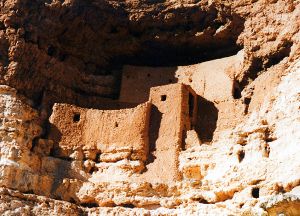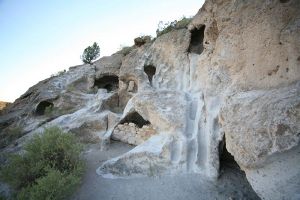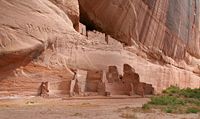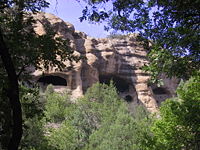Difference between revisions of "Cliff-dwelling" - New World Encyclopedia
| Line 25: | Line 25: | ||
;Bandelier National Monument | ;Bandelier National Monument | ||
| − | [[Bandelier National Monument]] in [[New Mexico]] is a 33,677 acres (13,629 ha) National Monument preserving the homes of the [[Ancestral Pueblo People]]. It is named after Swiss [[anthropologist]] [[Adolph Bandelier]], who researched the cultures of the area. Looking over the cliff dwellings, | + | [[Bandelier National Monument]] in [[New Mexico]] is a 33,677 acres (13,629 ha) National Monument preserving the homes of the [[Ancestral Pueblo People]]. It is named after Swiss [[anthropologist]] [[Adolph Bandelier]], who researched the cultures of the area. Looking over the cliff dwellings, Bandelier, announced "It is the grandest thing I ever saw."<ref name=nps1>National Park Service, [http://www.nps.gov/parkoftheweek/band.htm Bandolier National Monument]. Retrieved August 8, 2011.</ref> The Frijoles Canyon contains a number of cliff dwellings, as well as [[kiva]]s (ceremonial structures), [[rock painting]]s and [[petroglyph]]s. Some of the dwellings were rock structures built on the canyon floor; others were "cavates" produced by voids in the volcanic tuff of the canyon wall and carved out further by humans. |
[[Image:CACH-White House Ruin 50677ad3b7e84d159fde885f1b3839cf.jpg|thumb|200 px|Canyon de Chelly National Monument, Arizona, USA. White House Ruin]] | [[Image:CACH-White House Ruin 50677ad3b7e84d159fde885f1b3839cf.jpg|thumb|200 px|Canyon de Chelly National Monument, Arizona, USA. White House Ruin]] | ||
;Canyon de Chelly National Monument | ;Canyon de Chelly National Monument | ||
| − | Canyon de Chelly National Monument is located in northeastern [[Arizona]] within the boundaries of the [[Navajo]] Nation. | + | Canyon de Chelly National Monument is located in northeastern [[Arizona]] within the boundaries of the [[Navajo]] Nation. The monument covers 83,840 acres (131.0 sq mi; 339.3 km2) and encompasses the floors and rims of the three major canyons: de Chelly, del Muerto, and Monument. The site preserves ruins of the early indigenous tribes that lived in the area, including the [[Ancient Pueblo Peoples]] and Navajo. |
;Gila Cliff Dwellings National Monument | ;Gila Cliff Dwellings National Monument | ||
[[Image:Gila nm (overview).jpg|thumb|left|200 px|Cliff Dwellings in Gila]] | [[Image:Gila nm (overview).jpg|thumb|left|200 px|Cliff Dwellings in Gila]] | ||
Gila Cliff Dwellings National Monument is located in the Gila Wilderness within the Gila National Forest in southwestern [[New Mexico]]. It contains several archaeological sites from the [[Mogollon culture]]. | Gila Cliff Dwellings National Monument is located in the Gila Wilderness within the Gila National Forest in southwestern [[New Mexico]]. It contains several archaeological sites from the [[Mogollon culture]]. | ||
| − | The cliff contains the ruins of interlinked cave dwellings built in five cliff alcoves by the Mogollon peoples who lived in these cliff dwellings from between 1275 and 1300 | + | The cliff contains the ruins of interlinked cave dwellings built in five cliff alcoves by the Mogollon peoples who lived in these cliff dwellings from between 1275 and 1300 C.E.<ref>[http://www.nps.gov/gicl/ National Park Service official site for Gila Cliff Dwellings National Monument]</ref> Archeologists have identified 46 rooms in the five caves, and believd they were occupied by 10 to 15 families. The dwellings were a perfect place for human living. The caves provided adequate shelter, while the wooded area concealed the homes. The nearby area also provided for growing and finding food. |
;Honanki and Palatki | ;Honanki and Palatki | ||
| + | The Honanki Heritage Site is a cliff dwelling and [[rock art]] site located in the [[Coconino National Forest]], about 15 miles west of [[Sedona, Arizona]]. The [[Sinagua]] people, ancestors of the [[Hopi]], lived here from about 1100 to 1300 C.E.<ref>[http://www.fs.fed.us/r3/coconino/recreation/red_rock/honanki-ruins.shtml Honanki Heritage Site] at [[Coconino National Forest]]</ref>[[Honanki]] and [[Palatki]] were first studied by [[Jesse Walter Fewkes]] of the [[Smithsonian Institution]]. Fewkes named the site "Honanki," which means "Bear House" in the [[Hopi language]]. Honanki was one of the largest prehistoric pueblos in the [[Verde Valley]]. This period in Southern Sinagua prehistory is called the "Honanki Phase." Many of the cliff dwellings in the area west of Sedona were occupied during the Honanki Phase. The Sinagua occupation of Honanki was probably between 1130-1280 C.E., based on a [[Dendrochronology|tree-ring date]] of 1271 (from a wooden beam in the ruin) and other archaeological evidence.<ref name=USFSdoc>[http://rockart.esmartweb.com/palatki/paldoc.html Palatki and Honanki Ruins], handout by US Forest Service. This article incorporates [[public domain]] text from this and other [[US government]] documents.</ref> | ||
| + | |||
| + | Palatki Heritage Site is located in the Coconino National Forest in Sedona, Arizona. The word Palatki means 'red house' in the Hopi language. Built in the formidable red rock cliffs of the area are a set of ruins, dating from 1100 to 1400, belonging to the Sinagua. | ||
| + | |||
;Manitou Cliff Dwellings | ;Manitou Cliff Dwellings | ||
;Mesa Verde National Park | ;Mesa Verde National Park | ||
Revision as of 22:13, 8 August 2011
Cliff-dwelling is the general archaeological term for the habitations of prehistorical peoples, formed by using niches or caves in high cliffs, with more or less excavation or with additions in the way of masonry.
Types of Cliff-dwelling
Two special sorts of cliff-dwelling are distinguished by archaeologists;
- the cliff-house, which is actually built on levels in the cliff, and
- the cavate, which is dug out, by using natural recesses or openings.
Some of the most famous of these are the North American cliff-dwellings, particularly among the canyons of the southwest, in Arizona, New Mexico, Utah, Colorado, and Chihuahua in Mexico, some of which are still used by Native Americans. There has been considerable discussion as to their antiquity, but modern research finds no definite justification for assigning them to a distinct primitive race, or farther back than the Ancient Pueblo people, ancestors of the modern Pueblo people. The area in which they occur coincides with that in which other traces of the Pueblo tribes have been found. The niches which were used are often of considerable size, occurring in cliffs to a thousand feet in height, and approached by rock steps or log ladders.
Moki Steps
Moki steps, sometimes spelled alternately as Moqui steps, are a recurring feature found in areas of the American southwest previously inhabited by the Ancient Pueblo Peoples and other related cultures. The steps consist of alternating hand and toe holds carved into vertical or near-vertical sandstone surfaces. The steps are usually two to three inches deep, and three to four inches in width and height.
Moki steps are often found near cliff-dwellings and water sources. They may have allowed relatively quick access to difficult-to-reach areas such as slot canyons, look-out positions, and granaries. In some cases, Moki steps are thought to have provided access to fertile canyon bottoms from more defensible dwellings on or above surrounding cliffs. The steps may have been used in conjunction with handmade ropes.[1]
Similar sets of depressions may have been carved by non-indigenous settlers or explorers. In other cases, recent visitors may have deepened or widened a previously existing set of Moki steps.[2] There is no published criteria for determining the origin of a given set of steps.
Preserved Examples of Cliff-dwellings
United States
- Bandelier National Monument
Bandelier National Monument in New Mexico is a 33,677 acres (13,629 ha) National Monument preserving the homes of the Ancestral Pueblo People. It is named after Swiss anthropologist Adolph Bandelier, who researched the cultures of the area. Looking over the cliff dwellings, Bandelier, announced "It is the grandest thing I ever saw."[3] The Frijoles Canyon contains a number of cliff dwellings, as well as kivas (ceremonial structures), rock paintings and petroglyphs. Some of the dwellings were rock structures built on the canyon floor; others were "cavates" produced by voids in the volcanic tuff of the canyon wall and carved out further by humans.
- Canyon de Chelly National Monument
Canyon de Chelly National Monument is located in northeastern Arizona within the boundaries of the Navajo Nation. The monument covers 83,840 acres (131.0 sq mi; 339.3 km2) and encompasses the floors and rims of the three major canyons: de Chelly, del Muerto, and Monument. The site preserves ruins of the early indigenous tribes that lived in the area, including the Ancient Pueblo Peoples and Navajo.
- Gila Cliff Dwellings National Monument
Gila Cliff Dwellings National Monument is located in the Gila Wilderness within the Gila National Forest in southwestern New Mexico. It contains several archaeological sites from the Mogollon culture.
The cliff contains the ruins of interlinked cave dwellings built in five cliff alcoves by the Mogollon peoples who lived in these cliff dwellings from between 1275 and 1300 C.E.[4] Archeologists have identified 46 rooms in the five caves, and believd they were occupied by 10 to 15 families. The dwellings were a perfect place for human living. The caves provided adequate shelter, while the wooded area concealed the homes. The nearby area also provided for growing and finding food.
- Honanki and Palatki
The Honanki Heritage Site is a cliff dwelling and rock art site located in the Coconino National Forest, about 15 miles west of Sedona, Arizona. The Sinagua people, ancestors of the Hopi, lived here from about 1100 to 1300 C.E.[5]Honanki and Palatki were first studied by Jesse Walter Fewkes of the Smithsonian Institution. Fewkes named the site "Honanki," which means "Bear House" in the Hopi language. Honanki was one of the largest prehistoric pueblos in the Verde Valley. This period in Southern Sinagua prehistory is called the "Honanki Phase." Many of the cliff dwellings in the area west of Sedona were occupied during the Honanki Phase. The Sinagua occupation of Honanki was probably between 1130-1280 C.E., based on a tree-ring date of 1271 (from a wooden beam in the ruin) and other archaeological evidence.[6]
Palatki Heritage Site is located in the Coconino National Forest in Sedona, Arizona. The word Palatki means 'red house' in the Hopi language. Built in the formidable red rock cliffs of the area are a set of ruins, dating from 1100 to 1400, belonging to the Sinagua.
- Manitou Cliff Dwellings
- Mesa Verde National Park
- Montezuma Castle National Monument
- Navajo National Monument
- Puye Cliff Dwellings
- Sierra Ancha Cliff Dwellings
- Tonto National Monument
- Walnut Canyon National Monument
Mexico
- Cuarenta Casas
- Huápoca
Africa
- Bandiagara Escarpment
Asia
- Cappadocia
- Guyaju
- Kandovan
Europe
- Sassi di Matera
- Vardzia
ReferencesISBN links support NWE through referral fees
- ↑ Canyoneering, by John Annerino
- ↑ A Colorado River reader, by Richard F. Fleck
- ↑ National Park Service, Bandolier National Monument. Retrieved August 8, 2011.
- ↑ National Park Service official site for Gila Cliff Dwellings National Monument
- ↑ Honanki Heritage Site at Coconino National Forest
- ↑ Palatki and Honanki Ruins, handout by US Forest Service. This article incorporates public domain text from this and other US government documents.
References
- Noble, David Grant. Ancient Ruins of the Southwest. Flagstaff, AZ: Northland Publishing, 1991. ISBN 978-0873585309
- Oppelt, Norman T. Guide to Prehistoric Ruins of the Southwest. Boulder, CO: Pruett Publishing, 1989. ISBN 978-0871087836
- This article incorporates text from the Encyclopædia Britannica Eleventh Edition, a publication now in the public domain.
Gallery
External links
- 10 Fascinating Cave Dwellings in the World Touropia.com
- Palatki Heritage Site
- A 20th Century Cliff House
- The Cliff Dwellers Arizona Sketches by Joseph A. Monk.
- The Caves of Matera
| |||||
Credits
New World Encyclopedia writers and editors rewrote and completed the Wikipedia article in accordance with New World Encyclopedia standards. This article abides by terms of the Creative Commons CC-by-sa 3.0 License (CC-by-sa), which may be used and disseminated with proper attribution. Credit is due under the terms of this license that can reference both the New World Encyclopedia contributors and the selfless volunteer contributors of the Wikimedia Foundation. To cite this article click here for a list of acceptable citing formats.The history of earlier contributions by wikipedians is accessible to researchers here:
The history of this article since it was imported to New World Encyclopedia:
Note: Some restrictions may apply to use of individual images which are separately licensed.





